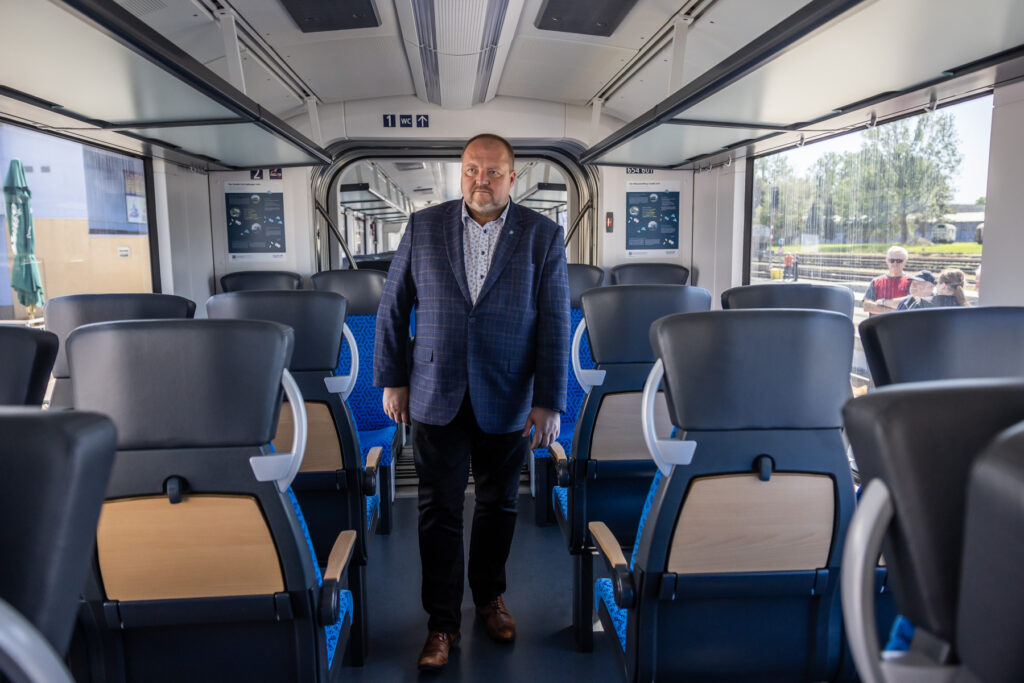What role do the different modes of transport play in the development of the region and what are the development priorities? We discussed this topic with Radek Podstawka, not only a railway enthusiast, but also the Deputy Governor responsible for transport.
As the Deputy Governor with a deep-rooted passion and background in railways, what have you achieved in the region and what future initiatives are you planning to implement in the area of transportation?
Thank you for this kind recognition. Indeed, I have been involved in the transport business for over 30 years, witnessing and contributing to numerous changes during this time. Over the past decade, I have actively shaped sectors such as public passenger transport, transport services, and the road infrastructure. In the last two years alone, we have launched several projects to enhance mobility in the region. For example, we have developed a high-speed railway corridor from the Olomouc Region to Ostrava, introduced PushPull units on the route between Ostrava and Frenštát pod Radhoštěm, and in collaboration with local towns and municipalities, we undertook the repair of Kaštanová Street in Třinec. Additionally, we constructed roundabouts in Ludgeřovice and Nový Jičín, completed bridge reconstructions in Dolní Sklenov, and made significant advances in rebuilding the bridge over the Lomná River in Trojanovice. It is also important to highlight our cooperation with the Ministry of Transport and the Road and Motorway Directorate of the Czech Republic, which led to the activation of the Karviná bypass, the northern Opava bypass, and the Třanovice – Nebory road, completing the connection from the Slovak border to highway D48.
The region invests significant resources in transportation. Could you explain what measures are being taken for the modernisation and environmental sustainability of rail transport?
This is indeed a fascinating subject. As I have highlighted before, the Moravian-Silesian region is a specific region in many respects, and the name “peculiar” is very close to that. Not only is it one of the three most structurally challenged regions, but it is also actively working to lower energy use and CO2 emissions in transportation significantly. We support both the construction of the transport infrastructure and the modernisation of the vehicle fleet. Simply put, using new vehicles on old tracks or old vehicles on new tracks is both uneconomical and environmentally unfriendly. Therefore, one initiative without the other is ineffective by itself.

You support the use of environmentally friendly transport on repaired roads within the region. Is this a feasible goal?
Indeed, this is closely related to the point made in my previous response. Simply repairing roads in the region or updating the transportation infrastructure, without also encouraging the use of modern, cleaner vehicles, would be neglectful. Achieving this goal requires not just new roads and vehicles, but also the critical supporting infrastructure such as charging stations for electric vehicles, alternative fuel stations, and more. One element without the other would be ineffective because unless we have, for example, a significant number of well-accessible charging points, we cannot expect any significant increase in low- or zero-emission vehicles. It is a vicious circle, yet the path forward involves promoting existing technologies that are already fairly widespread and have proven effective. There are also subsidy programmes available to help offset the high costs associated with building this necessary infrastructure. Introducing any new technology typically carries a high initial cost. Take, for example, the now widely available mobile phone, which only a fraction of the population could afford before 1997. Today, on the other hand, there is hardly anyone who has not used a mobile phone, at least in some simplified form.
The airport in Mošnov, owned by the region, is successfully developing in the field of cargo transport. What are the future development plans for this area?
Regarding passenger traffic, many have already noticed the commencement of the charter season at the airport in February. The airport now offers flights to 31 destinations across 14 countries. Alongside popular and familiar spots, 13 new destinations have been added including Lamezia Terme in Italy, Fuerteventura in the Canary Islands, Tirana in Albania, Chania on the Greek island of Crete, Thassos, Enfidha in Tunisia, Murcia in Spain, Dalaman in Turkey, and Marsa Matrouh in Egypt. For those intrigued by more distant lands, the news that flights from Ostrava will now include Thailand and Mauritius was particularly exciting. I believe that there will be a continued increase in passengers not only to the seaside but also on regular routes to London with Ryanair and to Warsaw with LOT Polish Airlines. These routes significantly enhance the global connectivity of the Moravian-Silesian Region. The development of the airport has also been significantly influenced by its growing cargo operations. Since April, the cargo flight network has been strengthened by a new regular route to Almaty, Kazakhstan. The inauguration of a new cargo terminal in October 2023 signifies another key phase in the development of Ostrava Airport. I am confident that Mošnov Airport is building dynamically on a very successful previous year. This trend is expected to be supported by an upcoming expansion of services at the terminal. We all are hopeful for the airport’s gradual and sustainable development.
Thank you for the interview.




